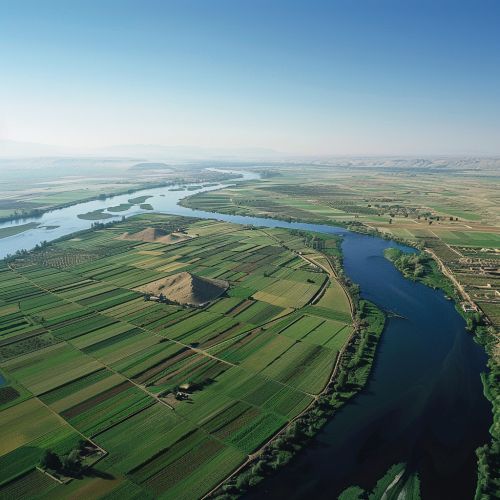Fertile Crescent
Origins and History
The Fertile Crescent is a term coined by Egyptologist James Henry Breasted in the early 20th century, referring to a region in the Middle East which curves, like a quarter-moon shape, from the Persian Gulf, through modern-day southern Iraq, Syria, Lebanon, Jordan, Israel and northern Egypt. The region has been recognized as the birthplace of agriculture, urbanization, writing, trade, science, history and organized religion and was home to the first advanced civilizations.
The term "Fertile Crescent" captures the unique combination of geographical features and environmental phenomena that led to an early pattern of human settlement in the region. The abundant water supply and favorable climate made it possible for ancient societies to develop agricultural technologies and establish sedentary communities.
The Fertile Crescent is traditionally associated with the early civilizations of Mesopotamia and the Levant. It was here that agriculture and animal domestication first took place in the world, during the Neolithic period. The development of these practices greatly altered human societies, leading to the establishment of settled communities and the rise of civilization.


Geography and Climate
The Fertile Crescent is characterized by its fertile soil, favorable climate, and abundance of water. The region is bounded on the east by the Zagros Mountains, on the west by the Mediterranean Sea, and on the south by the Arabian Desert. The northern part of the Fertile Crescent includes the eastern part of the Mediterranean Sea with its islands and the western part of the plateau of Iran. The southern part is made up of the valleys of the Tigris and Euphrates rivers, which flow from the mountains of eastern Turkey towards the Persian Gulf.
The climate of the Fertile Crescent is Mediterranean, characterized by mild, wet winters and hot, dry summers. The region receives most of its rainfall during the winter months, and the coastal areas receive more rainfall than the desert regions. The rich alluvial soil along the banks of the Tigris and Euphrates rivers is ideal for the cultivation of wheat, barley, and other cereal crops.
Agricultural Revolution
The Fertile Crescent is often referred to as the cradle of civilization, as it was here that the foundations of modern society - farming, the domestication of animals, and the development of writing - were laid. Around 10,000 BC, the inhabitants of the Fertile Crescent began to cultivate wild grains, which led to the development of agriculture.
This region was home to the first known instance of plant domestication, which led to farming, and the domestication of animals. The transition from foraging groups to agricultural communities had a profound impact on human societies. It led to the development of more complex social structures, specialization of labor, and the development of political structures. The surplus of food led to population growth and the formation of settled communities.
Ancient Civilizations
The Fertile Crescent was home to several ancient civilizations, including the Sumerians, Akkadians, Babylonians, Assyrians, and Persians. These civilizations made significant contributions to human culture, including the invention of the wheel, the development of cuneiform script, astronomy, mathematics, and law.
The Sumerians are considered the creators of civilization in the Fertile Crescent. They developed a form of writing known as cuneiform, which was later adopted by the Akkadians, Babylonians, and Assyrians. The Sumerians also made significant advances in technology, including the invention of the wheel and the plow.
The Akkadians, under their ruler Sargon, created one of the world's first empires. The Babylonians, who followed the Sumerians and Akkadians, are known for their law code, known as the Code of Hammurabi, one of the earliest known legal codes.
The Assyrians, based in northern Mesopotamia, were known for their military prowess and their vast empire, which at its height stretched from Egypt to Iran. The Persians, who came later, established one of the largest empires in history, stretching from the Indus River in the east to the Aegean Sea in the west.
Modern Significance
Today, the Fertile Crescent continues to be a region of significant geopolitical and cultural importance. It is home to numerous ethnic and religious groups, and it remains a focal point of geopolitical conflict and negotiation.
The region's rich history and cultural heritage make it a focus of archaeological and historical research. The ancient civilizations of the Fertile Crescent have left a lasting legacy on the world, influencing everything from our legal systems to our writing systems, from our agricultural practices to our religious beliefs.
See Also
Ancient Near East History of Agriculture Mesopotamian Civilization
